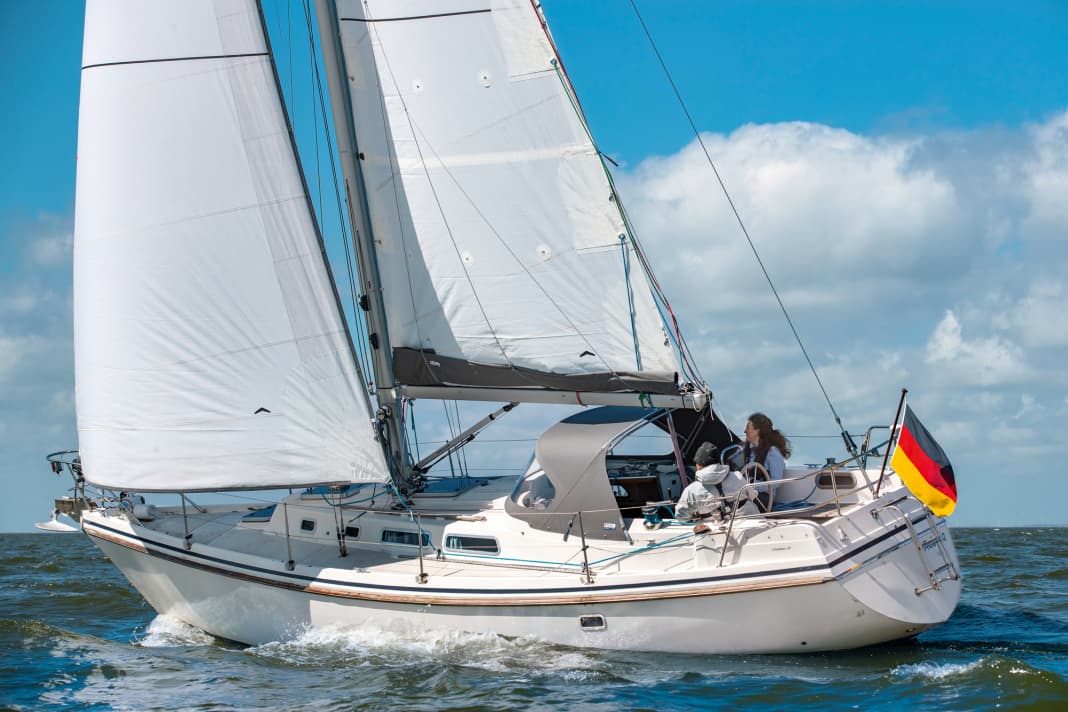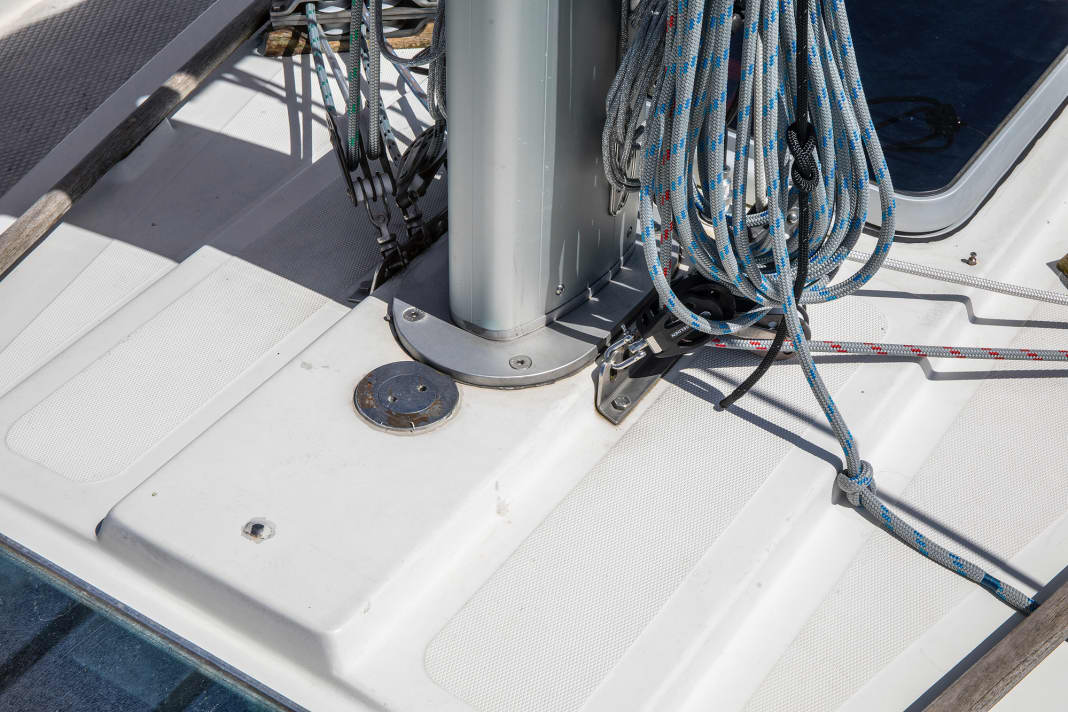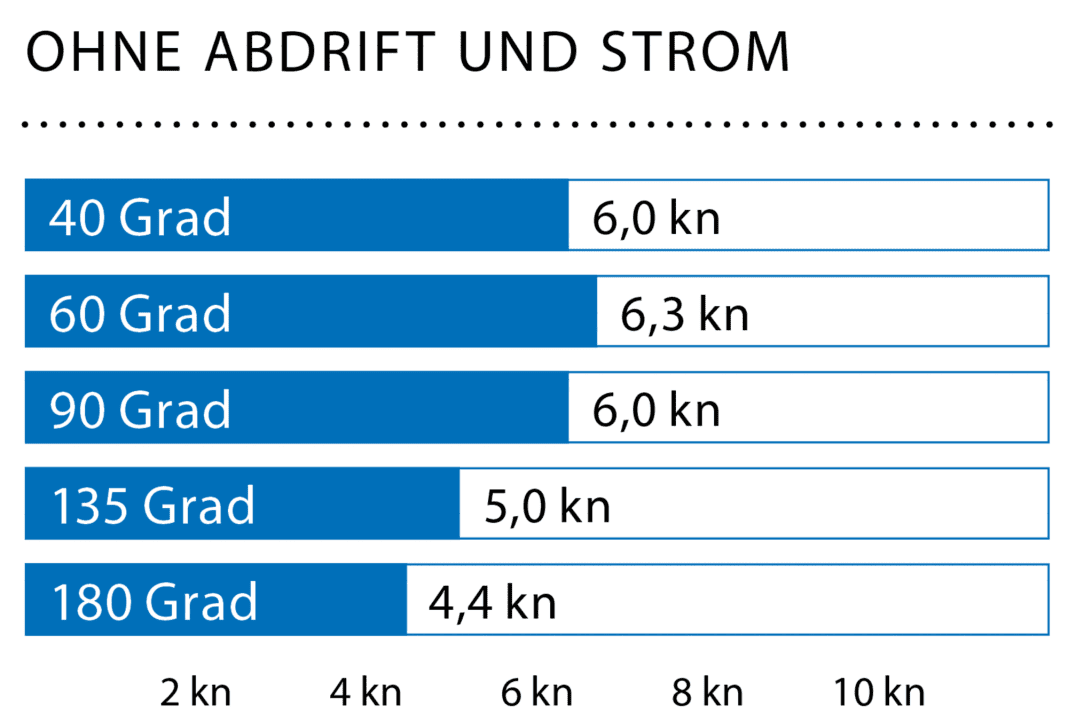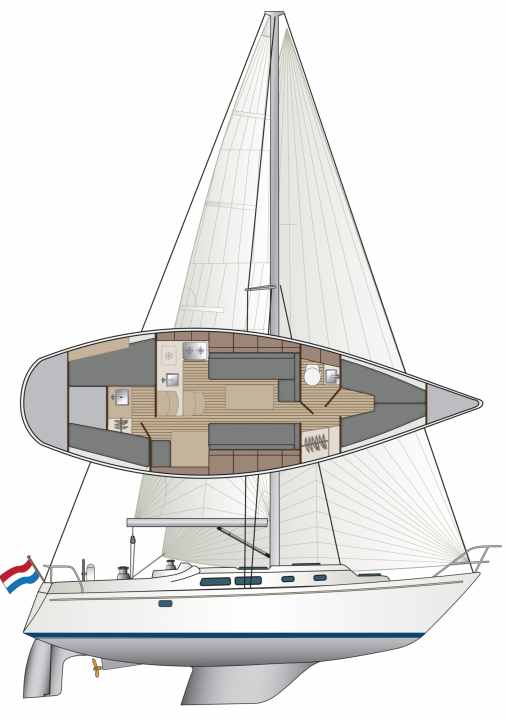





That was a shock: first there was a bang, then the forestay and furling jib drum flew off to the side. A few seconds later, the mast thundered onto the sprayhood. The baby stay had no chance of holding the spars and sails upright. And everything happened so quickly that falling off was no longer possible.
That was last year. The Contest 34 was still being used as a camera boat in another used boat test. The cause of the mast loss was quickly found: The boat had been fitted with a furling jib at some point during its life. The centre anchor fitting was therefore fitted with a construction to hold the drum. At the time, someone had tried their hand at a stainless steel welded construction: Sawed-off shroud tensioners were fixed to a sheet of metal. One of these welded seams then broke during a test on the choppy IJsselmeer after it had held for some time. The loss of the mast was unavoidable. A weak point that even the expert had not noticed during the purchase appraisal carried out shortly before.
More used boats in the test:
Since then, a lot has happened in and around construction number 72 out of a total of 84 produced: a new mast came on board as well as new sails and a new sprayhood. The height of the spar has remained the same. The boom was slightly longer, the mainsail therefore larger, and the genoa could be slightly smaller. The size of the genoa, which made it more difficult for the small crew to handle, was one of the points of criticism that our colleague Harald Schwarzlose discovered when testing the then new ship in 1977.
Used boat profile Contest 34
- Type: Contest 34
- Designer: Dick Zaal
- Built: 1976-1980
- Quantity: 84
- New price ready to sail: 109,265 DM
- Used price current: 18-35,000 euros
The Contest 34 was marketed as an IOR tonner. However, the measurement formula penalised area in the main. As IOR is no longer used for sailing and pricing today, this disadvantage can simply be eliminated with a new rig. That's what the sailmaker, rigger and owner did here. The 42 square metre genoa became 35, making it easier for the single-handed sailor to control. On the other hand, the main was increased from 22 to 26 square metres. That is enough for a sail carrying capacity of exactly 4 metres, which is not a lot. With the original area of the genoa, you would still get 4.2.
Good-natured or ponderous?
During the test in this millennium, the wind is blowing at 12 to 14 knots. This makes little impression on the Contest, it simply cruises along - at six knots at the cross, if the wind comes from the side, it is a little more. She doesn't like to pinch height, because then the speed drops rapidly. However, the luff of the new mainsail is still too long, making it a little too loose.
Otherwise, it is noticeable that the cockpit is spacious, but also easy to use under sail. The mainsheet on the bridge deck is just as easily accessible to the helmsman as the large genoa winches on the coaming. Whether you want to describe the sailing behaviour as confident or sedate is certainly in the eye of the beholder. Let's put it this way: the Contest raises no questions. The enormous weight of 7.4 tonnes provides a lot of momentum and therefore also more speed when you steer.
Contest 34 feels protected even in rougher conditions
Everything is there when it comes to trim: Backstay tensioner against the forestay sag, traveller, kicker, outhaul and the long genoa rails. But even with a brand new sail wardrobe, the Contest is hardly impressed. This is probably also due to the very direct, but also completely unfeeling mini steering wheel. You only notice some feedback from the rudder when you push harder. Owner Saskia is not bothered by this: she is often travelling single-handed and is delighted with the great directional stability, which also means lower power consumption for the autopilot.
By the way: During the test at the end of the seventies, the wind was blowing at 6 Beaufort, in gusts of 8 - conditions in which you wouldn't necessarily want to be on the IJsselmeer. But even then, the tester felt completely protected in the Contest, also thanks to a whopping 43 per cent ballast. And this is noticeable - perfect for family crews who want to take their first steps on bigger water with a safe boat. The layout below deck, which makes the Dutchwoman special, is also ideal for this.
Own world in the aft ship
Once you have squeezed your way between the high, 65-centimetre-wide bridge deck and the sprayhood into the companionway, the first thing you notice is the engine positioned far forward. The layout appears to be the same as always: a galley with cooker and oven, fridge and sink on the port side, then saloon benches on both sides and a passageway into the foredeck offset to starboard. Finally, a large navigation table.
Then a folding door opens next to the chart table. It may only be 1.52 metres high, but it leads into the aft cabin. There is a bunk on each side. And suddenly everything fits together: the high cockpit, the wide and equally high bridge deck and the engine positioned far forward - this is how the designer made room for this sleeping area in the stern.
On the port side, there is space for a 1.05 metre wide, but only 1.93 metre long berth; on the starboard side, the berth is 2.03 metres long, but only 67 centimetres wide. No matter, you can always sleep there. And it's ideal for a family with children: a cosy realm of its own for the youngsters, which can also be separated with a door. The aft cabin is ventilated through a small hatch to the cockpit. More windows would certainly need to be added here. You shouldn't be claustrophobic if you want to spend the night there. Nevertheless, the storage space under the berths is huge. Unfortunately, this is also where the unprotected hatches for the cockpit bilge pump are located. So be careful when stowing!
The layout of the interior is surprising, but can be pleasing
The headroom in the aft cabin is 1.66 metres, which is more suitable for children. Adults are better off stretching out further forward. In the saloon it is 1.93 to 1.97 metres, in the wet room under the hatch there it is as much as 2.05 metres. The standing area there is 0.95 by 0.80 metres.
According to the shipyard, this is supposed to be a shower room. The floor drains into the deep bilge via a hose, from where the automatic pump conveys the shower water to the outside - so it's better not to have any oil or diesel in the bilge when showering. There are also lockers right next to the shower - also not ideal. The practical usability of the shower remains to be seen, but theoretically there is a shower. At the time, the hot water for this came from a gas instantaneous water heater. However, these appliances are dangerous on boats due to carbon monoxide. If such a part, called a geyser, is still installed, it should be disconnected professionally.
Plenty of space at the front of the Contest 34
With a length of two metres and a width of 1.80 metres at shoulder height, the bunk in the foredeck is really large. Unfortunately, it becomes very shallow towards the feet, which prevents a relaxed night's sleep. There are useful storage compartments throughout the interior. This means that even a family of four can store enough equipment for a longer journey. As usual with Contest, the woodwork is very neat, depending of course on the previous owner's commitment. The interior was available with a choice of teak or mahogany surfaces.
The original MD 17C from Volvo Penta is still working on the test boat. Like the boat, the single-circuit cooled engine is 42 years old. After a complete overhaul a few years ago, it still works perfectly and starts immediately, even when cold. However, strong signs of smoke are evidence of wear inside; it is due for replacement in the next few years. With 36 hp, the Contest is generously equipped; 25 diesel horses were fitted as standard.
The owner and tester cannot understand the statement made by a colleague from the seventies that the Contest "can be manoeuvred backwards with pinpoint accuracy". It can only be steered against the wheel effect when the boat is travelling at a good speed. However, the typical Contest teak rubbing strakes are useful for line manoeuvres on the pole either way.
Solidly built, but sometimes osmosis is evident
Construction method: The floor assembly including keel and skeg were laminated separately. This allowed the keel to be filled with lead ballast, iron filings and polyester resin thickened with Portland cement. This entire floor assembly was then glued into an inwardly watertight recess in the hull and broadly laminated over. This created a very solid connection. What remained was a circumferential seam, which was filled with polyester filler. This filler absorbs moisture and crumbles out over the decades. On his website, designer Dick Zaal recommends simply sanding down the seam and then sealing it with epoxy filler. This would not cause any structural weakening.
The construction method has many advantages: There are no keel bolts, the connecting surface between keel and hull is huge and forces can be transferred easily. In addition, the connection is always watertight. Ships from Contest were and still are built under Lloyds supervision. The solid laminate is very thick, problems with softened core materials are not known with old boats. What does occur, however, is osmosis. The test ship has so far been spared this. At some point, however, the typical blisters will appear and the boat will have to be refurbished. The good thing about yachts from this shipyard is that the substance always justifies the expense.
Used boat prices are wide-ranging: Are the engine and rig new, and have they undergone osmosis treatment? Then such a Contest 34 can easily cost 35,000 euros. If much is still original, it can be bought for half that price. But then there is some work to be done. Owner Saskia recently completed a complete refit of the electrics. "A lot of work. But it was worth it," she summarises.
An older boat with quirks can therefore be a great boat for families with a small budget but good manual skills for a good time on the water. The Contest 34 is a solid and safe cruising boat with plenty of space and substance.
Pay attention to this
With used Contest 34, depending on the state of maintenance, particular attention should be paid to three possible weak points. Details can be found next to the pictures.





Market situation: trading difficult
A Contest 34 is currently on offer - priced at 34,000 euros. This emphasises the development since the purchase of the test boat five years ago, which cost 18,000 euros at the time. Three of the boats on offer still have the original engine, one even has a dilapidated teak deck. However, none of this is currently reducing the prices. The original engines have reached the end of their service life after 40 years, not least because spare parts are difficult to obtain or disproportionately expensive.
The measured values for testing the Contest 34




The Contest 34 in detail

Technical data of the Contest 34
- Designer: Dick Zaal
- Length over everything: 10,36 m
- Waterline length: 8,41 m
- Width: 3,40 m
- Depth: 1,75 m
- Weight: 7,4 t
- Ballast/proportion: 3,2 t/42 %
- Mainsail: 26,0 m2
- Furling genoa (125 %): 35,0 m2
- Machine (Volvo): 27 kW/36 hp
Hull and deck construction
Thick polyester solid laminates in hull and deck. Keel section including skeg glued into watertight recess
Price and shipyard
- Base price ex shipyard 1977: 55.860 €
- Price today: 18-35.000 €
- Built: 1976-1980
- Construction numbers: 001-084
Shipyard
Then Conyplex BV, today Contestyachts. Overleek 3, Medemblik on the IJsselmeer
YACHT evaluation of the Contest 34
A first-class entry-level yacht: inexpensive, solid, safe - but with a few construction sites that require craftsmanship or budget. Takes some getting used to in harbour manoeuvres, very good-natured under sail
Design and concept
- + Large cockpit
- + Good room layout for families
- - Little space in the aft chamber
Sailing performance and trim
- + Many trimming devices
- - Very sedate sailing characteristics
Living and finishing quality
- + Large headroom and bunks
- + High-quality wooden surfaces
- + Many practical storage options
Equipment and technology
- + Elaborate keel design
- + Well dimensioned fittings
- - Wood in the mast base
The Contest 34 in the video
The article first appeared in YACHT 13/2021 and has been updated for the online version.

